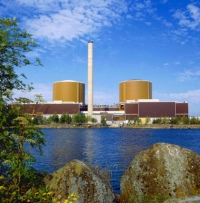New cooling towers will help to ensure safety at Finland's Loviisa nuclear power plant even if the seawater normally used to cool the plant were to be unavailable.
 |
| Loviisa (Image: Fortum ) |
Operator Fortum has announced that a new independent air cooling system will be constructed for Loviisa's two 448 MWe VVER pressurized water reactors . Two cooling towers will be constructed for each unit. One will remove decay heat from the reactor, the other will carry heat from used fuel pools and provide cooling for other equipment important for nuclear safety. The towers will be located in square buildings about ten metres high, with the towers for removing decay heat from the two reactors located in the same building.
The new towers will enhance safety at the plant in extreme conditions when seawater cannot be used. For example, an oil catastrophe in the Gulf of Finland or an exceptional natural phenomenon like an excessive algal growth.
Any power plant using a steam cycle relies on cooling regardless of whether it uses fossil fuels or nuclear energy to generate that steam. In normal operation, Loviisa's two units use about 40 cubic metres of sea water per second to cool the steam that powers the electricity generation turbines. The cooling water is then returned to the sea about 10ºC warmer, but otherwise unchanged.
Unlike fossil fuelled plants, nuclear reactors also require cooling when shut down to remove heat generated by radioactive decay. For this reason, nuclear plants are also equipped with emergency core cooling systems to ensure that cooling functions are not lost even if there is a major problem with the primary cooling system. Loviisa already has back-up systems to cope in the even ot a loss of seawater, but Fortum says that the new air cooling towers will reinforce the plant's safety still further.
Air cooling towers were identified as a development target in safety assessments carried out by Finnish nuclear regulator STUK as part of the European Union program of stress tests in response to the Fukushima Daiichi accident in Japan, although Fortum says it has been studying and developing the new seawater-independent cooling system for several years. The towers will be supplied by GEA EGI Contracting Engineering of Hungary, and the project will form part of Loviisa's annual investment program. The work will be carried out during 2014.
Researched and written
by World Nuclear News




_82983.jpg)
_34792.jpg)
_16403_79272.jpg)


_76087_55556.jpg)



